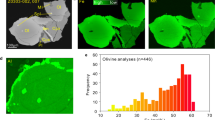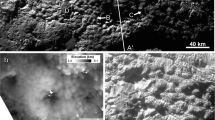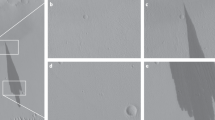Abstract
The bulk of basaltic magmatism on the Moon occurred from 3.9 to 3.1 billion years ago on the ancient lunar mare plains1. There is evidence for basaltic volcanism as recently as 2.9 billion years ago from crystallization ages2 and a billion years ago from stratigraphy3,4. An enigmatic surface formation named Ina (18.65° N, 5.30° E) may represent much younger mare volcanism, but age estimates are poorly constrained5,6,7,8. Here we investigate 70 small topographic anomalies, termed irregular mare patches (100–5,000 m maximum dimension), on the lunar nearside with irregular morphologies and textures similar to Ina, using Lunar Reconnaissance Orbiter narrow angle camera images9, digital terrain models and wide angle camera colour ratios. The irregular mare patches exhibit sharp, metre-scale morphology with relatively few superposed impact craters larger than ten metres in diameter. Crater distributions from the three largest irregular mare patches imply ages younger than 100 million years, based on chronology models of the lunar surface10,11. The morphology of the features is also consistent with small basaltic eruptions that occurred significantly after the established cessation of lunar mare basaltic volcanism. Such late-stage eruptions suggest a long decline of lunar volcanism and constrain models of the Moon’s thermal evolution.
This is a preview of subscription content, access via your institution
Access options
Subscribe to this journal
Receive 12 print issues and online access
$259.00 per year
only $21.58 per issue
Buy this article
- Purchase on Springer Link
- Instant access to full article PDF
Prices may be subject to local taxes which are calculated during checkout



Similar content being viewed by others
References
Basaltic Volcanism Study Project, Basaltic Volcanism on the Terrestrial Planets 1286 (Pergamon, 1981).
Borg, L. E., Shearer, C. K., Asmerom, Y. & Papike, J. J. Prolonged KREEP magmatism on the Moon indicated by the youngest dated lunar igneous rock. Nature 432, 209–211 (2004).
Schultz, P. H. & Spudis, P. D. Beginning and end of lunar mare volcanism. Nature 302, 233–236 (1983).
Hiesinger, H., Head, J. W., Wolf, U., Jaumann, R. & Neukum, G. Ages and stratigraphy of lunar mare basalts: A synthesis. GSA Special Papers 477, 1–51 (2011).
Whitaker, E. A. in Apollo 15 Preliminary Science Report, NASA SP-289, Ch. 25, 84–85 (NASA, 1972)
El-Baz, F. in Apollo 17 Preliminary Science Report, NASA SP-330, Ch. 30, 13–17 (NASA, 1973)
Strain, P. L. & El-Baz, F. The geology and morphology of Ina. Proc. Lunar Sci. Conf. 11, 2437–2446 (1980).
Schultz, P. H., Staid, M. I. & Pieters, C. M. Lunar activity from recent gas release. Nature 444, 184–186 (2006).
Robinson, M. S. et al. Lunar Reconnaissance Orbiter Camera (LROC) instrument overview. Space Sci. Rev. 150, 81–124 (2010).
Neukum, G., Ivanov, B. A. & Hartmann, W. K. Cratering records in the inner solar system in relation to the lunar reference system. Space Sci. Rev. 96, 55–86 (2001).
Michael, G. G. & Neukum, G. Planetary surface dating from crater size-frequency distribution measurements: Partial resurfacing events and statistical age uncertainty. Earth Planet. Sci. Lett. 294, 223–229 (2010).
Garry, W. B. et al. The origin of Ina: Evidence for inflated lava flows on the Moon. J. Geophys. Res. 117, E00H31 (2012).
Hiesinger, H. et al. How old are young lunar craters? J. Geophys. Res. 117, E00H10 (2012).
Gault, D. E. Saturation and equilibrium conditions for impact cratering on the lunar surface: Criteria and implications. Radio Sci. 5, 273–291 (1970).
Lucey, P. G., Blewett, D. T., Taylor, G. J. & Hawke, B. R. Imaging of lunar surface maturity. J. Geophys. Res. 105, 20377–20386 (2000).
Zanetti, M., Jolliff, B. L., van der Bogert, C. H. & Hiesinger, H. New determination of crater size-frequency distribution variation on continuous ejecta deposits: Results from Aristarchus crater. Lunar Planet. Sci. Conf. 44, abstr. 1842 (2013).
Brett, R. Thicknesses of some lunar mare basalt flows and ejecta blankets based on chemical kinetic data. Proc. Lunar Sci. Conf. 6, 1135–1141 (1975).
Schaber, G. G. Lava flows in Mare Imbrium: Geologic evaluation from Apollo orbital photography. Proc. Lunar Sci. Conf. 4, 73–92 (1973).
Staid, M. I. et al. The spectral properties of Ina: New observations from the Moon Mineralogy Mapper. Lunar Planet. Sci. Conf. 42, abstr. 2499 (2011).
Jolliff, B. L., Gillis, J. J., Haskin, L. A., Korotev, R. L. & Wieczorek, M. A. Major lunar crustal terranes: Surface expressions and crust-mantle origins. J. Geophys. Res. 105, 4197–4216 (2000).
Warren, P. H. & Wasson, J. T. The origin of KREEP. Rev. Geophys. Space Phys. 17, 73–88 (1979).
Head, J. W. & Wilson, L. Lunar mare volcanism: Stratigraphy, eruption conditions, and the evolution of secondary crusts. Geochim. Cosmochim. Acta 56, 2155–2175 (1992).
Wieczorek, M. A. & Phillips, R. J. The ‘Procellarum KREEP Terrane’: Implications for mare volcanism and lunar evolution. J. Geophys. Res. 105, 20417–20430 (2000).
Kneissl, T., van Gasselt, S. & Neukum, G. Map-projection-independent crater size-frequency determination in GIS environments-New software tool for ArcGIS. Planet. Space Sci. 59, 1243–1254 (2011).
McEwen, A. S. & Bierhaus, E. B. The importance of secondary cratering to age constraints on planetary surfaces. Annu. Rev. Earth Planet. Sci. 34, 535–567 (2006).
Schultz, P. H. & Spencer, J. Effects of substrate strength on crater statistics: Implications for surface ages and gravity scaling. Proc. Lunar Sci. Conf. 10, 1081–1083 (1979).
van der Bogert, C. H. et al. Discrepancies between crater size-frequency distributions on ejecta and impact melt pools at lunar craters: An effect of differing target properties? Lunar Planet. Sci. Conf. 41, abstr. 1533 (2010).
Dundas, C. M., Keszthelyi, L. P., Bray, V. J. & McEwen, A. S. The role of material properties in the cratering record of young platy-ridged lava on Mars. Geophys. Res. Lett. 37, L12203 (2010).
Stöffler, D. & Ryder, G. Stratigraphy and isotope ages of lunar geologic units: Chronological standard for the inner solar system. Space Sci. Rev. 96, 9–54 (2001).
Boyd, A. K., Robinson, M. S. & Sato, H. Lunar Reconnaissance Orbiter Wide Angle Camera photometry: An empirical solution. Lunar Planet. Sci. Conf. 43, abstr. 2795 (2012).
Acknowledgements
This work was funded by the Lunar Reconnaissance Orbiter project and would not have been possible without the hard work of the Lunar Reconnaissance Orbiter Camera Science Operations Center team. Thank you to R. Wagner for help with figure preparation.
Author information
Authors and Affiliations
Contributions
S.E.B. and M.S.R. conceived and designed the analyses. S.E.B. collected and analysed data; J.D.S. and S.E.B. both documented and characterized new IMPs. S.J.L. assisted in the interpretation of remote sensing data. C.H.v.d.B. and H.H. aided in the methodology and interpretation of CSFDs. S.E.B. wrote the manuscript with inputs from all authors.
Corresponding author
Ethics declarations
Competing interests
The authors declare no competing financial interests.
Supplementary information
Supplementary Information
Supplementary Information (PDF 3061 kb)
Rights and permissions
About this article
Cite this article
Braden, S., Stopar, J., Robinson, M. et al. Evidence for basaltic volcanism on the Moon within the past 100 million years. Nature Geosci 7, 787–791 (2014). https://doi.org/10.1038/ngeo2252
Received:
Accepted:
Published:
Issue Date:
DOI: https://doi.org/10.1038/ngeo2252
This article is cited by
-
A lunar time scale from the perspective of the Moon’s dynamic evolution
Science China Earth Sciences (2024)
-
Volcanism in the Solar System
Science China Earth Sciences (2023)
-
Dark spots on Mercury show no signs of weathering during 30 Earth months
Communications Earth & Environment (2022)
-
Planetary volcanology: progress, problems, and opportunities
Bulletin of Volcanology (2022)
-
Two-billion-year-old volcanism on the Moon from Chang’e-5 basalts
Nature (2021)



